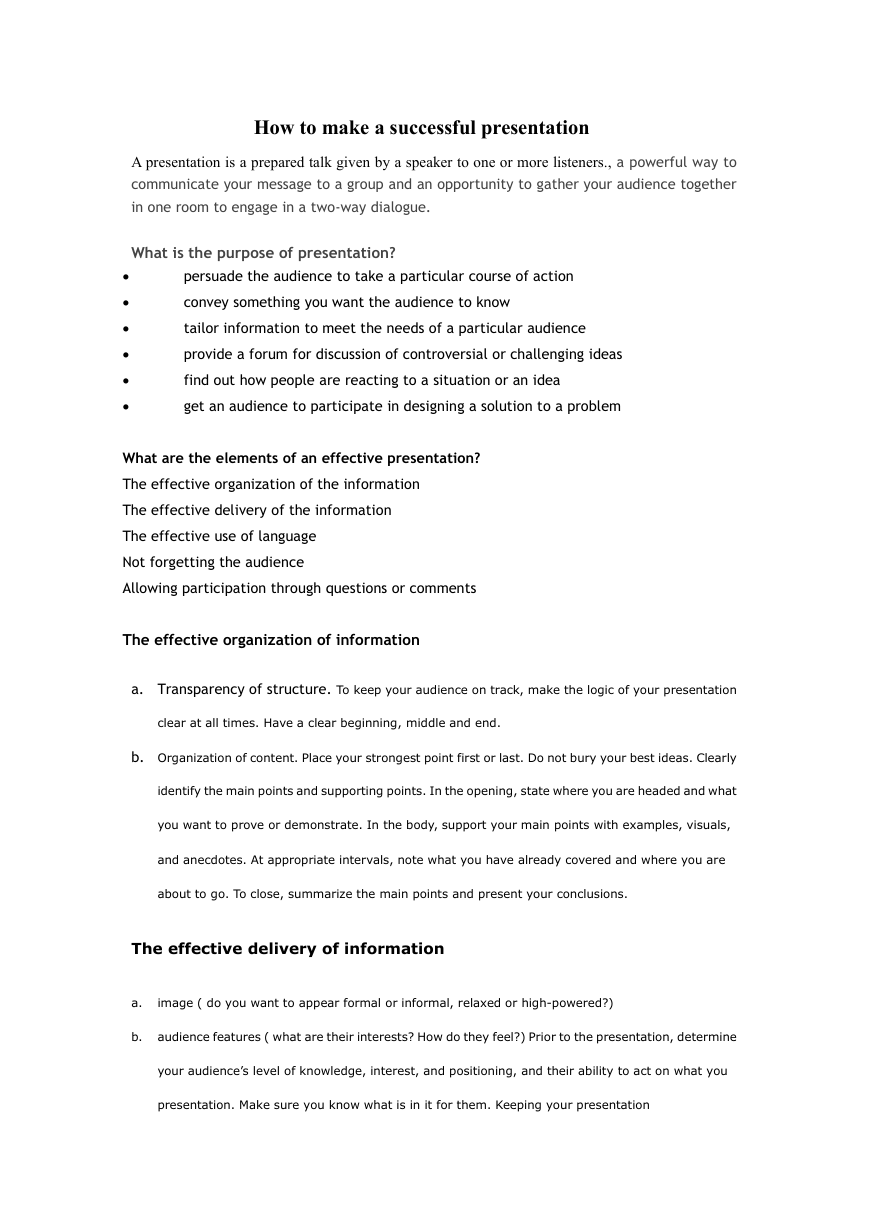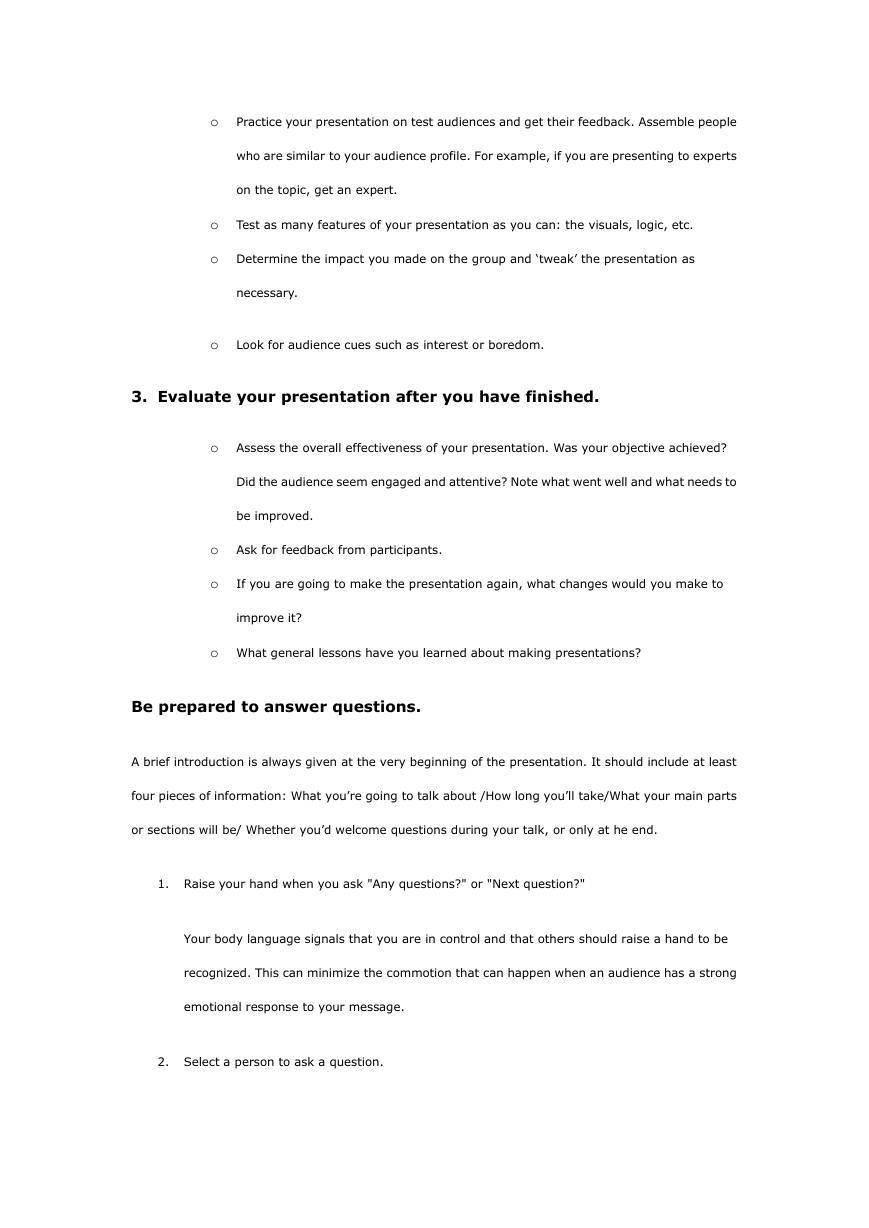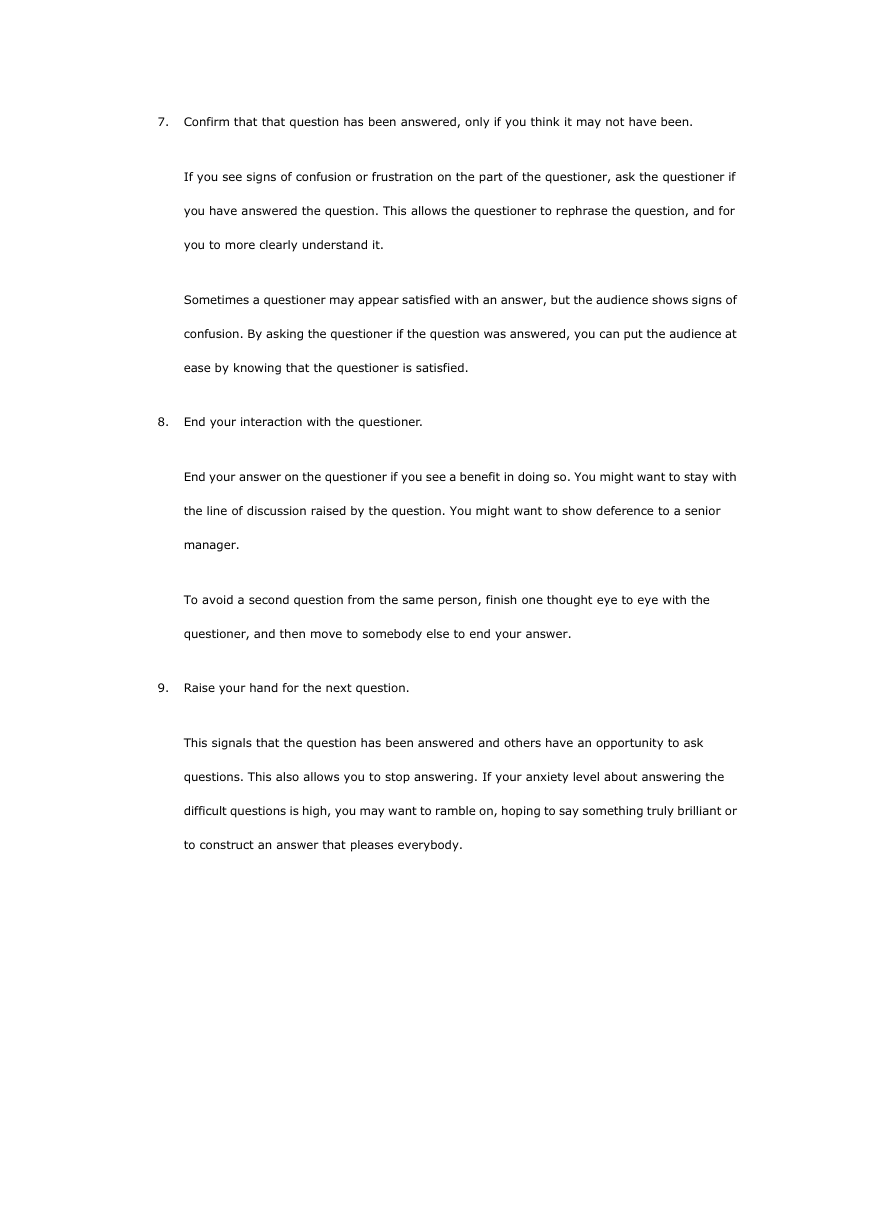How to make a successful presentation
A presentation is a prepared talk given by a speaker to one or more listeners., a powerful way to
communicate your message to a group and an opportunity to gather your audience together
in one room to engage in a two-way dialogue.
What is the purpose of presentation?
persuade the audience to take a particular course of action
convey something you want the audience to know
tailor information to meet the needs of a particular audience
provide a forum for discussion of controversial or challenging ideas
find out how people are reacting to a situation or an idea
get an audience to participate in designing a solution to a problem
What are the elements of an effective presentation?
The effective organization of the information
The effective delivery of the information
The effective use of language
Not forgetting the audience
Allowing participation through questions or comments
The effective organization of information
a. Transparency of structure. To keep your audience on track, make the logic of your presentation
clear at all times. Have a clear beginning, middle and end.
b. Organization of content. Place your strongest point first or last. Do not bury your best ideas. Clearly
identify the main points and supporting points. In the opening, state where you are headed and what
you want to prove or demonstrate. In the body, support your main points with examples, visuals,
and anecdotes. At appropriate intervals, note what you have already covered and where you are
about to go. To close, summarize the main points and present your conclusions.
The effective delivery of information
a.
b.
image ( do you want to appear formal or informal, relaxed or high-powered?)
audience features ( what are their interests? How do they feel?) Prior to the presentation, determine
your audience’s level of knowledge, interest, and positioning, and their ability to act on what you
presentation. Make sure you know what is in it for them. Keeping your presentation
�
audience-focused is critical.
If you are not familiar with the group, ask the liaison for the meeting
to give you some background. If possible, try to contact at least one person who fits the audience
profile.
c. Non-linguistic techniques ( use of suitable body language and eye contact)
d.
Technical support ( use of visual aids, e.g. slides, diagrams on a flipchart, transparencies and power
point help listeners remember facts, understand ideas, relationships, or physical layouts, recognize
that you are moving on to a new topic.)
The use of language
a.
b.
c.
d.
e.
vocabulary ( choose the right word for spoken rather than written language)
grammar ( assemble the sentence correctly in terms of language forms)
pronunciation ( stress words correctly)
fluency ( variation in sentence structure and length)
speed ( link your ideas, and don’t talk too quickly)
How to practice and evaluate your presentation?
1. Rehearse.
o
o
o
o
o
o
Rehearse with the equipment and visuals you will actually use at the event.
Rehearse the entire presentation each time you practice, including how you are going
to stand, move, and how you are going to use the visuals.
Rehearse out loud.
Rehearse until the presentation does not sound memorized.
Concentrate on the subject or message and your desire to communicate, not on your
notes.
If the presentation is a high profile one to a large group, you can videotape your
practice session to evaluate it more closely.
2. Gather feedback prior to your presentation.
�
o
Practice your presentation on test audiences and get their feedback. Assemble people
who are similar to your audience profile. For example, if you are presenting to experts
on the topic, get an expert.
Test as many features of your presentation as you can: the visuals, logic, etc.
o
o Determine the impact you made on the group and ‘tweak’ the presentation as
necessary.
o
Look for audience cues such as interest or boredom.
3. Evaluate your presentation after you have finished.
o
o
o
Assess the overall effectiveness of your presentation. Was your objective achieved?
Did the audience seem engaged and attentive? Note what went well and what needs to
be improved.
Ask for feedback from participants.
If you are going to make the presentation again, what changes would you make to
improve it?
o What general lessons have you learned about making presentations?
Be prepared to answer questions.
A brief introduction is always given at the very beginning of the presentation. It should include at least
four pieces of information: What you’re going to talk about /How long you’ll take/What your main parts
or sections will be/ Whether you’d welcome questions during your talk, or only at he end.
1. Raise your hand when you ask "Any questions?" or "Next question?"
Your body language signals that you are in control and that others should raise a hand to be
recognized. This can minimize the commotion that can happen when an audience has a strong
emotional response to your message.
2. Select a person to ask a question.
�
This keeps several people from talking at once. If you gesture, be sure to use an open palm
instead of pointing to show you are nondefensive but still in charge.
3.
Look directly at the questioner and listen for the issue behind the question.
This will help you to better understand the question. As you listen, ask yourself, "What's the
issue? What's the point here?" Many speakers begin thinking of the answer when they should be
listening and, as a result, miss the real question. If you are not sure about the meaning of the
question, ask for clarification. Avoid saying that the question isn't clear (it may be clear to
everyone but you); rather, say that you do not understand it.
4.
Paraphrase the question.
o
o
o
Restate if the question is simple and straightforward.
Rephrase to simplify a long or complicated question.
Rephrase to put a negative or hostile question into neutral words.
This ensures that everyone hears the question, gives you a few moments to think of your
answer and choose your best approach, simplifies the question, and neutralizes it. Be careful
not to change the issue when you rephrase a question. The questioner, and others, will
recognize this immediately and become suspicious of your motives. The purpose for this type of
rephrasing is to get at the real issues.
5. When the question is finished, break visually with the questioner and lock eyes with another
person.
This will help avoid one-to-one conversations and signals to your audience that the answer will
be of interest to all. (In very small groups this may not be appropriate.)
6.
Look back to the questioner during your answer. When possible, tie your answer back to the key
messages in your presentation.
By looking back to the questioner for part of your answer, you can check for the reaction. Your
tie back reinforces your main points.
�
7. Confirm that that question has been answered, only if you think it may not have been.
If you see signs of confusion or frustration on the part of the questioner, ask the questioner if
you have answered the question. This allows the questioner to rephrase the question, and for
you to more clearly understand it.
Sometimes a questioner may appear satisfied with an answer, but the audience shows signs of
confusion. By asking the questioner if the question was answered, you can put the audience at
ease by knowing that the questioner is satisfied.
8. End your interaction with the questioner.
End your answer on the questioner if you see a benefit in doing so. You might want to stay with
the line of discussion raised by the question. You might want to show deference to a senior
manager.
To avoid a second question from the same person, finish one thought eye to eye with the
questioner, and then move to somebody else to end your answer.
9. Raise your hand for the next question.
This signals that the question has been answered and others have an opportunity to ask
questions. This also allows you to stop answering. If your anxiety level about answering the
difficult questions is high, you may want to ramble on, hoping to say something truly brilliant or
to construct an answer that pleases everybody.
�










 2023年江西萍乡中考道德与法治真题及答案.doc
2023年江西萍乡中考道德与法治真题及答案.doc 2012年重庆南川中考生物真题及答案.doc
2012年重庆南川中考生物真题及答案.doc 2013年江西师范大学地理学综合及文艺理论基础考研真题.doc
2013年江西师范大学地理学综合及文艺理论基础考研真题.doc 2020年四川甘孜小升初语文真题及答案I卷.doc
2020年四川甘孜小升初语文真题及答案I卷.doc 2020年注册岩土工程师专业基础考试真题及答案.doc
2020年注册岩土工程师专业基础考试真题及答案.doc 2023-2024学年福建省厦门市九年级上学期数学月考试题及答案.doc
2023-2024学年福建省厦门市九年级上学期数学月考试题及答案.doc 2021-2022学年辽宁省沈阳市大东区九年级上学期语文期末试题及答案.doc
2021-2022学年辽宁省沈阳市大东区九年级上学期语文期末试题及答案.doc 2022-2023学年北京东城区初三第一学期物理期末试卷及答案.doc
2022-2023学年北京东城区初三第一学期物理期末试卷及答案.doc 2018上半年江西教师资格初中地理学科知识与教学能力真题及答案.doc
2018上半年江西教师资格初中地理学科知识与教学能力真题及答案.doc 2012年河北国家公务员申论考试真题及答案-省级.doc
2012年河北国家公务员申论考试真题及答案-省级.doc 2020-2021学年江苏省扬州市江都区邵樊片九年级上学期数学第一次质量检测试题及答案.doc
2020-2021学年江苏省扬州市江都区邵樊片九年级上学期数学第一次质量检测试题及答案.doc 2022下半年黑龙江教师资格证中学综合素质真题及答案.doc
2022下半年黑龙江教师资格证中学综合素质真题及答案.doc